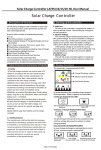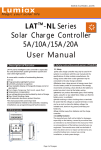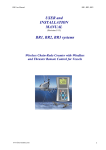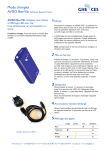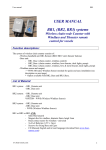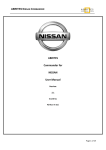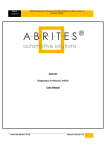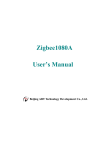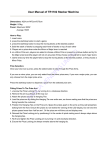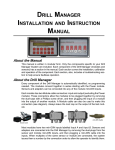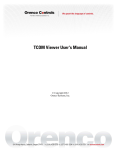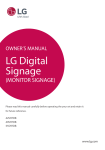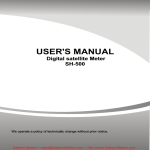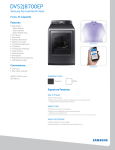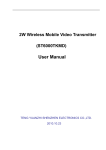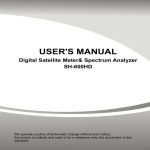Download Lat user manual
Transcript
LAT Ser ies So lar Char ge Cont roller 5A /10A /15A /20A User Manual Solar Charge Controller LAT05/10/15/20 User Manual Sol ar Charge Con trol ler 3.Starting up the controller 1.Description of Function LAT series intelligent solar controller is especially for solar photovoltaic power generation system. It comes with a number of outstanding features, such as: ●12V/24V automatic recognition ●Clear readable display of charge/discharge and error description ●Four stages charge way: fast, boost, equal, float ●Temperature compensation ●Low voltage disconnected reulated by state of charge ●Max. 16mm² binding clamp ●Full automatic electronic protect function This manual provides some important recommendations related to the controller, including installation, use, programming and fault exclusion. 2.Safety instructions and waiver of liability 3 . 1Sel f Te s t As s o on as t h e c on t roll e r is s u ppl i e d with b att e r y, it s t a r ts a s elf test routin e . Then the display change s t o normal operation . 3.2Syst e m Vo lt a ge The controller a djusts its e lf automatically to 12 V or 24V system v ol tage. A s s oon as the batter y vol t a g e at the ti m e of star t- up is wit h in 10V t o 16V, t h e c on t roll e r im p lies a 12V sy s tem, el s e if the batter y v ol t a g e is wit h in 2 0V to 30 V,the controller i mpl i e s a 2 4 V s y stem. If t h e ba t te r y voltage is not withi n the no r ma l operatin g r a n g (ca. 1 0 to 1 6 V or ca.20 t o 30V)at star t- u p, a status d i splay accordi n g t o the section 5 . 2 Error desc r iption o c cur. 3.3Batter y Type The LAT seri e s c on t rol ler appl i es to L iq u id and Gel ba t te r y, the facto r y d e fault set t ing is s u i table for l i qu i d ba t te r y. 4.Display Functions The controller is equipped with 5 LEDS. 2.1 Safety ①The solar charge controller may only be used in PV Charge/Discharge display systems in accordance with this user manual and the specifications of other modules manufacturers. No Battery Capacity display energy source other than a solar generator may be connected to the solar charge controller. Load status display ②Batteries store a large amount of energy, never short circuit a battery under all circumstances. We strongly recommend connecting a fuse directly to the battery to protect any short circuit at the battery wiring. ③Batteries can produce flammable gases. Avoid making sparks, using fire or any naked flame. Make sure that the In normal operation,the controller shows charge or discharge status、battery capacity and load status. battery room is ventilated. 4.1Charge display(Green LED): ④Avoid touching or short circuiting wires or terminals. Be aware that the voltages on special terminals or wires can be as much as twice the battery voltage. Use Solar array supplies electricity (LED is on) isolated tools, stand on dry ground, and keep your hands dry. Solar array does not supply electricity (LED is off) 4.2Status of charge display(Yellow LED): ⑤Keep children away from batteries and the charge controller. 2.2 Liability Exclusion The manufacturer shall not be liable for damages, especially on the batter y, caused by use other than as intended or as mentioned in this manual or if the recommendations of the batter y manufacturer are neglected. The manufacturer shall not be liable if there has been ser vice or repair carried out by any <25% 25-75% >75% The percentage corresponds to the available energy until low voltage disconnect in relation to a fully charged batter y. 4.3Load status display(Red LED): In case of deep discharge or overload/short-circuit of load, the load output is switched off. unauthorized person, unusual use, wrong installation, or bad system design. Low voltage Overload or short-circuit Normal operation disconnect(LED is on) of load(LED is flashing) (LED is off ) Page 1 of 3 pages Solar Charge Controller LAT05/10/15/20 User Manual 5.Safety Features and Error description 5.1 Safety features Solar terminal Battery terminal Load terminal Reverse polarity Protected *1 Protected *1 Short circuit Protected Protected *3 Protected Over voltage Max.55V *4 Max. 40V Under voltage Over temp. Switches off immediately Switches off with delay Over current Reverse Current Protected *2 6.Low Voltage Disconnect Function The controller uses state of charge to protect the batter y form being deeply discharged: 11.2V/22.4V~11.8V/23.6V. Disconnect at 11.2V/22.4V(at nominal load current) up to 11.8V/23.6V(at no load current). 1.If the controller goes into low voltage protection, it will restore only when the battery being recharged and the voltage reaching the reconnect voltage. 2.Around oblique line value separately on behalf of 12V and 24V system's value. 7.Mounting and Connecting Switches off switches off the load if the temperature reaches the set value. *1 Controller can not protect itself in a 24V system when polarity of battery or solar is reversed. *2 Controller can protect itself, but loads might be damaged. *3 Battery must be protected by fuse, or battery will be permanently damaged. *4 The solar panel voltage should not exceed this limit for a long time as voltage protection is done by a varistor. Warning: The combination of different error conditions may cause damage to the controller. Always remove the error before you continue connecting the controller. The controller is intended for indoor use only. Protect it from direct sunlight and place it in a dr y environment. Never install it in humid rooms(like bathrooms). The controller measures the ambient temperature to determine the charging voltage. Controller and batter y must be installed in the same room. The controller warms up during operation, and should therefore be installed on a non flammable surface only. Remark: Connect the controller by following the steps described below to avoid installation faults. ① 5.2 Error description Error Loads are not supplied Display Battery is not being charged during the day Remedy Batter y is low Load will reconnect as soon as battery is recharged Over current/ short circuit of loads Switch off all loads. Remove short circuit. Batter y has low capacity Change batter y Red LED is on Red LED is flashing Battery is empty after a short time Reason Red LED is on Solar array faulty Green LED or wrong polarity is off Batter y voltage over voltage protection Does not recognize the system voltage too high (>15.5V/31V) Remove faulty connection/ reverse polarity Check if other sources overcharge the battery. If not, controller is damaged. Red and Yellow LED Battery wires or (the right Check batter y battery fuse side) are wires,fuse and damaged, battery lighted batter y. has high resistance The batter y voltage is not Charge or discharge All LED within the normal the battery to make the voltage within Lighted operating rang at start-up the normal range Mount the controller to the wall with screws that fit to the wall material. Use screws with max.4mm shaft and max.7.5mm head diameter, no counter sunk . Mind that the screws have to carr y also the force applied by the wiring. ② Connect the wires leading to the batter y with correct polarity. To avoid any voltage on the wires, first connect the controller, then the batter y. We strongly recommend connecting a fuse directly to the batter y to protect any short circuit at the batter y wiring. The fuse must take the charge controller nominal current: LAT05: 20A; LAT10/15: 30A; LAT20: 40A. Mind the recommended wire length: Min 30cm to max 100cm. The wire size: LAT05: min2.5m m 2 LAT10: min6m m 2 LAT15/20: min10m m 2 Warning: If the battery is connected with reverse polarity, the load terminals will also have the wrong polarity. Never connect loads during this condition. Page 2 of 3 pages Solar Charge Controller LAT05/10/15/20 User Manual ③ Connect the wires leading to the solar array with correct polarity, to avoid any voltage on the wires, first connect the controller then the Solar array. Mind the recommended wire size: 2 LAT05: min 2.5 m m LAT10: min 6 m m 2 2 LAT15/20: min 10 m m 8.Grounding the Solar System Be aware that the positive terminals of the controller are connected internally and therefore have the same electrical potential. If any grounding is required always do this on the positive wires. Remark: Place positive and negative wire close to each other to minimize electromagnetic effects. Solar panels provide voltage as soon as exposed to sun light .Mind the solar panel manufacturer ’s recommendations in any case. ④ Connect the wires leading to the loads with correct polarity. To avoid any voltage on the wires, first connect the wire to the load, then to the controller. Remark: If the device is used in a vehicle which has the battery negative on the chassis, loads connected to the controller must not have an electric connection to the car body, otherwise the Low Voltage disconnect and electronic fuse functions of the controller are short circuited. Mind the recommended wire size: 2 LAT05: min 2.5 m m LAT10: min 6 m m 2 2 LAT15/20: min 10 m m 9.Technical Data Model LAT05 LAT10 System voltage 12V/24V automatic recognition Max. solar current or load current 5A Fast voltage 14.0V/28.0V(25℃) 10A Boost voltage 14.5V/29.0V (25℃) Equalization voltage 14.8V/29.6 V (25℃)(Liquid) Float voltage 13.7V/27.4 V (25℃) Load disconnect voltage 11.2~11.8V/22.4~23.6V Load reconnect voltage 12.5V/25.0V LAT15 LAT20 15A 20A Battery type Liquid、Gel Temperature Compensation -4.17 mV/K per cell(Boost, Equalization); -3.33 mV/K per cell(Float) Max. solar voltage 55V Max. ba ttery voltage 40V Over voltage protection 15.5V/31.0V Dimensions/ Weight 81*102*37 / 150g Wire size 16mm²(AWG#6) Own consumption 4mA Ambient temperature -40 ~ +60 ℃ Degree of protection IP22 Subject to change without notice. Version: DC14 Page 3 of 3 pages




